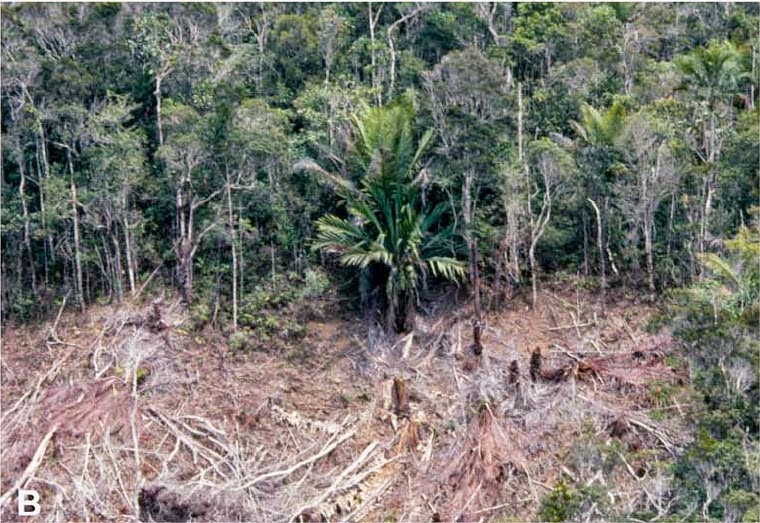Ants are often highly adaptable animals, and many species have
proven to be highly invasive pests, able to reach new homes by hitching a ride
on cargo moved by Humans, and often proceeding modify the environment in their
new homes, to the detriment of organisms already living there. The Yellow Crazy
Ant, Anoplolepis gracilipes, is
considered to be one of the world’s top 100 invasive species, and has had a
catastrophic impact on the ecosystems of a number of small islands. The origin
of the Yellow Crazy Ant is unknown, though it is thought to come from central
East Africa or an unknown location in Asia, but is now distributed widely in
tropical and subtropical ecosystems; everywhere it has been encountered it is
an invasive species, rapidly modifying its new environment with its 24 hour aggressive foraging and wide
food tolerances.
In a paper published in the journal NeoBiota on 26 June 2014,
Christopher Kaiser-Bunbury of the Seychelles Islands Foundation and Ecological Networks at Technischen Universität Darmstadt, Harriet Cuthbert of the Centre for Ecology, Evolutionand Conservation at the University of East Anglia, Rebeckah Fox of the Seychelles
Islands Foundation and the Centre for Ecology, Evolution and Conservation at
the University of East Anglia and Darryl Birch and Nancy Bunbury of the Seychelles
Islands Foundation describe the impact of the Yellow Crazy Ant on the Vallée de Mai Palm Forest of Praslin Island in the Seychelles.
The Vallée de Mai Palm Forest is one of the last surviving areas of
relatively undisturbed Island Palm Forest in the Seychelles, and indeed the
world. As such it is a UNESCO designated World Heritage Site considered
extremely important by conservationists, as well as an area of renowned natural
beauty which is a major attraction for tourists, tourism being a major industry
in the Seychelles. The forest is dominated by the iconic Coco de Mer Palm, Lodoicea maldivica, which is famous for
producing the world’s largest seed, and is home to a wide range of endemic (not
found anywhere else) animals and plants.
A Coco de Mer Palm, Lodoicea maldivica, in the Jardin botanique de Kandy. Wikimedia Commons.
Yellow Crazy Ants were first reported in the Seychelles on the
island of Mahé in 1962. They reached Praslin by 1975, but were eradicated by
the rapid implementation of control measures. Since then they have spread
across the archipelago, and by 2000 were established on nine of the central
islands, including Praslin again. They were first sighted in Vallée de Mai in
August 2009, prompting an extensive survey of the park in March-June 2010,
followed by subsequent surveys in April and December 2012.
Kaiser-Bunbury et al.
report that in 2010 Yellow Crazy Ants occupied 28% of the Vallée de Mai. By
April 2012 they occupied 36% of the area, with 12% of the park newly occupied
and 4% previously occupied but now abandoned by the Ants. By December 2012 the
range occupied by the Ants had contracted to 28% again, with no new areas
invaded. The area invaded by the Ants was in the northeastern corner of the
forest, where a new visitor centre, constructed in 2007-09, and it is likely
that the Ants were introduced with building materials brought to the site for
this project, and that the operating visitor centre was also facilitating the
continued presence of the ants in an area where they otherwise appeared to have
difficulty becoming established, possibly by providing the Ants with additional
sources of food.
Within the invaded areas the Ants were most abundant on the ground,
though they were clearly able to climb the Coco de Mer trees and even move from
tree-to-tree within the canopy. The Ants were more abundant in introduced where they were
tending two species the honeydew-producing Hemipterans (Bugs) Pulvinariaur bicola and Icerya seychellarum, both of which are
introduced species. Many Ant species cultivate sap-suckingHemipterans in this
way, relying on the carbohydrate-rich honeydew as a source of food, and Yellow
Crazy Ants have been observed to utilise a variety of species in this way.
Hemipterans are not usually able to able to feed from Palms, however, making it
harder for the Ants to find a food source there.
In areas where the Ants were present the numbers of indigenous
Molluscs living in the Palms was greatly reduced, and one species, the White
Slug, Vaginula seychellensis, was
completely excluded. Several species of Lizards also showed reduced numbers,
particularly the Bronze Gecko, Ailuronyx tachyscopaeus,
though one species, the Day Gecko, Phelsuma astriata,
showed an increase in numbers. It was not clear whether Phelsuma astriata was prospering because it was able to utilise the
Ants as a food source, or because of increased access to its natural food
supply, the pollen produced by the male Coco de Mer trees, which is also
consumed by several other species of Gecko and Mollusc (though this is produced
in great abundance all year round and not usually thought to be a limiting
resource).
See also…
Madagascar is considered to be one of the world’s biodiversity
hotspots. The island has an area of 592 750 km2 and is located in
the southern Indian Ocean, giving it a tropical climate with a diverse range of
habitats..
Ants and Termites are eusocial Insects that have dominated many
tropical ecosystems since at least the Early Cretaceous. Relationships between
the two groups (which are not closely related) are complex, with some species
able to tolerate one-another and even share nests, while others are deeply
hostile, typically with Ants feeding on Termites or Termites fighting to keep
all Ants away from their territories. However...
Leafcutter Ants harvest vegetation from the tropical rainforests of
South and Central America, which they then carry back to their nests and
use as feed in fungal farms. Each species of Ant has its own unique...
Follow Sciency Thoughts on Facebook.


.jpg)



